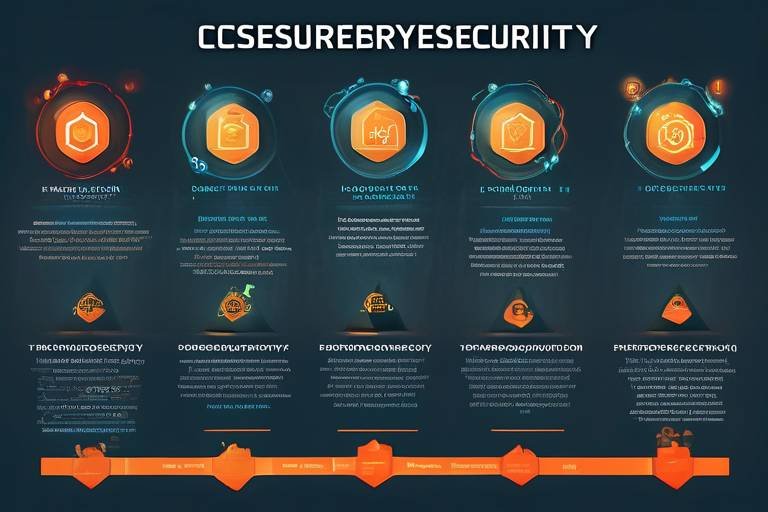Cybersecurity for Retailers - Protecting Your Customers' Data
In today's digital age, where shopping has evolved from brick-and-mortar stores to online platforms, the significance of cybersecurity cannot be overstated. Retailers are not just selling products; they are also custodians of sensitive customer information, including credit card details, addresses, and personal preferences. With this wealth of information at stake, it’s crucial for retailers to implement robust cybersecurity measures to protect their customers' data. Imagine if your favorite store suddenly became a victim of a data breach—your personal information could be exposed, leading to identity theft or fraud. This scenario is not just a fear; it's a reality that many retailers face today.
As the retail landscape continues to shift towards e-commerce, the number and sophistication of cyber threats have surged. From phishing attacks that trick employees into revealing sensitive information, to malware that can infiltrate systems and steal data, retailers must be vigilant. The potential impact of these cyberattacks is staggering, not only in terms of financial loss but also in the erosion of customer trust. When customers feel that their data is not secure, they’re likely to take their business elsewhere. Therefore, understanding these threats is the first step in crafting an effective cybersecurity strategy.
In this article, we will delve into the best practices that retailers can adopt to enhance their cybersecurity posture. We will explore the importance of employee training, the necessity of regular security audits, and the critical role of incident response plans. Additionally, we will look at technological solutions that can bolster data protection. Furthermore, compliance with regulations such as GDPR and CCPA will be discussed, highlighting their implications for retailers. Lastly, we will emphasize the importance of building customer trust through effective cybersecurity measures.
Cyber threats come in various forms, each with its own methods and motivations. Retailers face a multitude of risks, including:
- Phishing: Deceptive emails or messages designed to trick employees into revealing sensitive information.
- Malware: Malicious software that can infiltrate systems, often leading to data breaches.
- DDoS Attacks: Distributed Denial of Service attacks that overwhelm online platforms, rendering them inaccessible.
- Ransomware: Malware that locks access to data, demanding payment for its release.
Each of these threats has the potential to compromise customer data, leading to significant financial and reputational damage to retailers. Understanding these threats not only helps in crafting effective defenses but also prepares retailers to respond swiftly should an incident occur.
Implementing best practices is crucial for safeguarding customer data. Retailers can enhance their cybersecurity posture by adopting essential strategies such as:
One of the most significant risks in cybersecurity is human error. Employees who are unaware of cybersecurity protocols can inadvertently expose sensitive information. Therefore, training staff on cybersecurity awareness is vital. Regular training sessions can equip employees with the knowledge to recognize phishing attempts, understand the importance of strong passwords, and follow safe browsing practices. Think of your employees as the first line of defense; if they are well-informed, they can help thwart many potential threats before they escalate.
Conducting regular security audits is another cornerstone of effective cybersecurity. These audits help identify vulnerabilities within a retailer's systems, allowing for timely remediation. By evaluating the effectiveness of existing security measures, retailers can proactively address weaknesses before they are exploited by cybercriminals. Regular assessments can be likened to routine health check-ups; just as you wouldn’t wait for a serious illness to seek medical help, you shouldn’t wait for a breach to assess your cybersecurity health.
Having a solid incident response plan is vital for any retailer. Such a plan should outline the steps to take in the event of a data breach, including communication strategies, containment procedures, and recovery processes. An effective incident response plan not only mitigates the impact of a breach but also helps in regaining customer trust. Think of this plan as your emergency exit strategy; it’s essential to have one in place before a crisis hits.
Leveraging technology is essential for robust cybersecurity. Retailers can utilize various tools and solutions, such as:
- Firewalls: To block unauthorized access to networks.
- Encryption: To protect sensitive data both in transit and at rest.
- Intrusion Detection Systems: To monitor networks for suspicious activity.
By integrating these technologies, retailers can create a multi-layered defense that significantly reduces the risk of data breaches.
Adhering to data protection regulations is critical for retailers. Regulations like the General Data Protection Regulation (GDPR) and the California Consumer Privacy Act (CCPA) set stringent guidelines for how customer data should be handled. Understanding these regulations is essential for retailers operating in affected regions, as non-compliance can lead to severe consequences.
The GDPR aims to protect EU citizens' data privacy, while the CCPA focuses on California residents. Both regulations emphasize transparency in data handling and grant consumers the right to know how their data is used. Retailers must ensure that their data practices align with these regulations to avoid hefty fines and legal repercussions.
Failing to comply with data protection regulations can have severe consequences. Retailers may face:
- Legal Repercussions: Lawsuits and penalties from regulatory bodies.
- Financial Loss: Fines that can reach millions of dollars.
- Reputational Damage: Loss of customer trust and brand loyalty.
In today's competitive market, maintaining compliance is not just about avoiding penalties; it's about building a trustworthy relationship with customers.
Trust is paramount in retail. Customers want to feel secure when sharing their personal information. By implementing effective cybersecurity measures, retailers can enhance customer confidence and loyalty. Imagine walking into a store where you know your data is safe; you’re more likely to return, right? Similarly, in the digital realm, strong cybersecurity can be a significant differentiator for retailers, setting them apart in a crowded marketplace.
Q: What are the most common cyber threats faced by retailers?
A: Retailers commonly face threats such as phishing, malware, DDoS attacks, and ransomware.
Q: How can retailers train their employees on cybersecurity?
A: Retailers can conduct regular training sessions, workshops, and simulations to educate employees about cybersecurity best practices.
Q: What should be included in an incident response plan?
A: An incident response plan should include communication strategies, containment procedures, and recovery processes.
Q: Why is compliance with regulations important?
A: Compliance is crucial to avoid legal repercussions, financial losses, and reputational damage.
Q: How can retailers build customer trust?
A: By implementing robust cybersecurity measures and being transparent about data handling practices.

Understanding Cyber Threats
In today's digital age, the retail sector faces a multitude of cyber threats that can compromise customer data and tarnish a brand's reputation. From the moment a customer enters their personal information on a website to the time they make a purchase, their data is vulnerable to various forms of cyberattacks. Understanding these threats is the first step toward effective protection. Cyber threats can manifest in numerous ways, with some of the most common being:
- Phishing Attacks: These deceptive tactics often come in the form of emails or messages that appear to be from legitimate sources, tricking users into revealing sensitive information.
- Malware: This malicious software can infiltrate systems, stealing data or damaging files, often without the user's knowledge.
- Ransomware: A particularly insidious form of malware that locks users out of their systems until a ransom is paid, often targeting retailers with sensitive customer data.
- Data Breaches: When unauthorized access to a retailer's system occurs, it can lead to significant data leaks, exposing customer information to cybercriminals.
These threats not only pose risks to customer data but also threaten the very foundation of trust that retailers work hard to build. Imagine walking into a store, only to find that your personal information has been compromised; that's the reality many customers face when their data is mishandled or attacked online. The impact of these threats can be devastating, leading to financial losses, legal repercussions, and a damaged reputation.
Furthermore, the impact of cyber threats extends beyond immediate financial concerns. Retailers may face long-term repercussions such as loss of customer loyalty and trust. A single data breach can lead to customers questioning the safety of their information, causing them to seek alternatives that prioritize cybersecurity. In fact, studies show that consumers are increasingly aware of data security issues and are more likely to shop with retailers that demonstrate a commitment to protecting their information.
Retailers must stay informed about the evolving landscape of cyber threats. As technology advances, so do the tactics employed by cybercriminals. Regular training and updates on the latest threats can empower employees to recognize and respond to potential risks. By fostering a culture of security awareness, retailers can significantly reduce the likelihood of falling victim to cyberattacks.
In conclusion, understanding cyber threats is crucial for retailers aiming to protect their customers' data. By recognizing the various forms of attacks and their potential consequences, retailers can implement stronger defenses and safeguard their operations. Remember, in the world of retail, knowledge is power, and being proactive about cybersecurity can make all the difference in maintaining customer trust and loyalty.

Best Practices for Data Protection
In the ever-evolving landscape of retail, where transactions occur at the speed of light, safeguarding customer data has become a top priority. Retailers must adopt best practices to ensure that sensitive information remains secure. Implementing these practices is not just a recommendation; it’s a necessity in today's digital age. So, what can retailers do to enhance their cybersecurity posture and protect their customers' data? Let's dive into some essential strategies that can make a significant difference.
First and foremost, employee training and awareness play a critical role in data protection. A common saying in cybersecurity is that the weakest link in the chain is often the human element. Employees need to be educated about the various cyber threats they might encounter, such as phishing emails or suspicious links. Regular workshops and training sessions can empower staff with the knowledge they need to identify and respond to potential threats effectively. When employees are aware of the risks and know how to mitigate them, the overall security of the organization improves dramatically.
Consider this: if your employees are like the front line of a castle, then training is akin to arming them with the right weapons. They need to know how to defend against intruders. By fostering a culture of security awareness, retailers can significantly reduce the likelihood of human error leading to data breaches. This involves not just initial training but ongoing education, keeping staff updated on the latest threats and security protocols.
Next, conducting regular security audits is essential. Think of these audits as routine check-ups for your cybersecurity health. Just as you wouldn’t skip a doctor’s appointment, you shouldn’t overlook the importance of assessing your security measures. These audits help identify vulnerabilities in your systems and processes, allowing you to patch up any weak spots before they can be exploited by cybercriminals. A systematic approach to conducting these audits can involve evaluating software, hardware, and even employee practices to ensure that every aspect of your operations is secure.
In the unfortunate event of a data breach, having a solid incident response plan is vital. This plan acts as a roadmap, guiding retailers on how to respond quickly and effectively to minimize damage. Key components of an effective incident response plan include:
- Identification: Recognizing and classifying the type of breach.
- Containment: Taking immediate steps to limit the breach's impact.
- Eradication: Eliminating the root cause of the breach.
- Recovery: Restoring systems and data to normal operations.
- Lessons Learned: Analyzing the incident to improve future responses.
By preparing for the worst-case scenario, retailers can not only mitigate the damage caused by a breach but also reassure customers that their data is being taken seriously.
Finally, leveraging technology solutions is essential for robust cybersecurity. Retailers should consider investing in advanced security software, firewalls, and encryption tools to protect customer data. For instance, employing end-to-end encryption ensures that sensitive information is scrambled and unreadable during transmission, making it much harder for hackers to intercept and misuse. Additionally, implementing multi-factor authentication (MFA) adds an extra layer of security, requiring users to verify their identity through multiple means before accessing sensitive systems.
In conclusion, the best practices for data protection in retail are not merely guidelines; they are a comprehensive strategy that combines education, regular assessments, and technological solutions. By taking these proactive steps, retailers can create a secure environment that not only protects customer data but also fosters trust and loyalty. After all, in the competitive world of retail, maintaining customer trust is as valuable as the data itself.
Q: Why is employee training important for data protection?
A: Employee training is crucial because human error is often the weakest link in cybersecurity. Educated employees can better recognize and respond to potential threats.
Q: What should be included in an incident response plan?
A: An effective incident response plan should include steps for identification, containment, eradication, recovery, and lessons learned from the incident.
Q: How can technology enhance data protection?
A: Technology solutions like encryption, firewalls, and multi-factor authentication can significantly bolster a retailer's cybersecurity defenses by making it harder for unauthorized access to occur.

Employee Training and Awareness
In the bustling world of retail, it's easy to underestimate the power of human error when it comes to cybersecurity. Employees are the backbone of any retail operation, but they can also be the weakest link in the cybersecurity chain. Imagine a well-guarded fortress where the gate is left ajar because someone forgot to lock it. That's what happens when staff are not adequately trained in cybersecurity protocols. are crucial components of a robust cybersecurity strategy, and here's why.
First and foremost, it's essential to recognize that cyber threats are constantly evolving. Cybercriminals are always on the lookout for new ways to exploit vulnerabilities, and often, those vulnerabilities lie in human behavior. Employees may inadvertently fall victim to phishing scams, leading to data breaches that compromise sensitive customer information. Therefore, regular training sessions are vital. These sessions should cover a variety of topics, including:
- Identifying phishing emails and suspicious links
- Understanding the importance of strong passwords
- Recognizing social engineering tactics
- Reporting suspicious activity promptly
Moreover, creating a culture of cybersecurity within the organization can significantly reduce risks. When employees understand the importance of their role in protecting customer data, they become more vigilant. This proactive approach can be likened to a neighborhood watch program—when everyone is looking out for suspicious activity, the community as a whole is safer.
It's also vital to engage employees in hands-on training exercises. Simulated phishing attacks can be a fun yet educational way to test their knowledge and preparedness. These exercises not only reinforce the training but also provide valuable feedback on areas that may need more attention. By making training interactive, retailers can ensure that their staff retains the information better and feels more confident in their ability to identify threats.
Furthermore, ongoing training is just as important as initial training. Cybersecurity is not a one-and-done deal; it requires continuous education. Regular updates on new threats and tactics should be part of the training regimen. Think of it as a sports team that practices regularly to stay sharp. The more they practice, the better they perform during the game.
In summary, investing in employee training and awareness is not just a good practice; it's a necessity for retailers looking to protect their customers' data. By fostering an environment where employees feel empowered and informed, retailers can significantly mitigate risks and enhance their overall cybersecurity posture.
Q: Why is employee training important for cybersecurity?
A: Employee training is crucial because human error is often the leading cause of data breaches. Well-trained employees can recognize threats and respond appropriately, reducing the risk of security incidents.
Q: How often should training be conducted?
A: Regular training should be conducted at least annually, with additional sessions whenever new threats arise or when significant changes in policies occur.
Q: What topics should be covered in cybersecurity training?
A: Training should cover recognizing phishing attempts, the importance of strong passwords, social engineering tactics, and how to report suspicious activities.

Regular Security Audits
In the ever-evolving landscape of cybersecurity, are not just a good practice; they are essential for any retailer serious about protecting customer data. Think of these audits as routine health check-ups for your business's digital infrastructure. Just as you wouldn't ignore your health, you shouldn't neglect the security of your systems. Regular audits help identify vulnerabilities before they can be exploited by cybercriminals, ensuring that your defenses are always up to date.
During these audits, various aspects of your cybersecurity framework are evaluated. This includes examining your network security, data protection measures, and compliance with relevant regulations. By conducting thorough assessments, you can uncover weaknesses that might otherwise go unnoticed. For instance, outdated software or misconfigured firewalls can create easy access points for attackers. Regular audits allow you to address these issues proactively.
Moreover, audits should not be a one-time event but rather a continuous process. Establishing a schedule—be it quarterly, bi-annually, or annually—depends on the size of your organization and the nature of your operations. Consider the following key elements to include in your audit schedule:
- Vulnerability Scanning: Regularly scan your systems for known vulnerabilities and apply necessary patches.
- Access Control Reviews: Ensure that only authorized personnel have access to sensitive data and systems.
- Incident Response Testing: Simulate potential cyber incidents to evaluate the effectiveness of your response plan.
Additionally, involving third-party cybersecurity experts can provide an unbiased perspective on your security posture. These professionals can offer insights and recommendations that may not be apparent from within your organization. They can also assist in ensuring compliance with industry standards and regulations, which is increasingly important in a world where data breaches can lead to hefty fines and reputational damage.
In summary, regular security audits are a crucial component of a comprehensive cybersecurity strategy. By identifying vulnerabilities, ensuring compliance, and enhancing your incident response capabilities, you can significantly reduce the risk of a data breach. Remember, in the world of cybersecurity, staying ahead of threats is key to maintaining your customers' trust and safeguarding their sensitive information.
Here are some common questions retailers have regarding cybersecurity and the importance of regular security audits:
- How often should I conduct a security audit? It is recommended to conduct audits at least annually, but more frequent audits may be necessary for larger organizations or those handling sensitive information.
- What should I do if vulnerabilities are found during an audit? Address any identified vulnerabilities immediately, prioritizing those that pose the greatest risk to your data security.
- Can I perform audits in-house? While in-house audits can be beneficial, involving third-party experts is often recommended for a more thorough and unbiased assessment.

Incident Response Plans
In today's digital landscape, having a solid incident response plan (IRP) is not just a luxury; it's a necessity for retailers. Imagine waking up to find that your store has been breached overnight—customer data exposed, sales records compromised, and your reputation hanging by a thread. An effective IRP can mean the difference between a minor hiccup and a catastrophic failure. But what exactly should this plan entail?
At its core, an incident response plan is a well-structured approach to managing the aftermath of a cybersecurity incident. It provides a roadmap for your team to follow, ensuring that everyone knows their role and responsibilities when a breach occurs. This minimizes chaos and confusion, allowing for a swift recovery. Here are some key components that should be included in your IRP:
- Preparation: This involves training your staff, establishing communication protocols, and ensuring that necessary tools and resources are in place before an incident occurs.
- Identification: Quickly recognizing an incident is critical. Your team should be trained to detect unusual activity and report it immediately.
- Containment: Once an incident is identified, the next step is to contain the threat to prevent further damage. This could involve isolating affected systems or taking certain services offline.
- Eradication: After containment, the root cause of the incident must be identified and eliminated. This may involve removing malware, closing vulnerabilities, or even changing passwords.
- Recovery: Once the threat is eradicated, systems can be restored to normal operations. It's essential to monitor the systems closely for any signs of weakness that could lead to another incident.
- Lessons Learned: After the dust settles, it's vital to review what happened. Conducting a post-incident analysis helps identify what worked, what didn’t, and how to improve future responses.
Additionally, it's crucial to establish a communication plan that outlines how to inform customers, stakeholders, and regulatory bodies about the incident. Transparency can go a long way in maintaining trust, even in the face of adversity. By effectively communicating what happened and what steps are being taken to rectify the situation, retailers can reassure customers that their data is being taken seriously.
In summary, a robust incident response plan is a retailer's best ally in the battle against cyber threats. It not only prepares your team to respond effectively but also helps mitigate damage and restore normalcy in the aftermath of an incident. Remember, the goal isn't just to survive an attack but to emerge from it stronger and more resilient than before.
1. What is an incident response plan?
An incident response plan is a documented strategy that outlines how an organization will respond to a cybersecurity incident, detailing roles, responsibilities, and procedures to follow.
2. Why is an incident response plan important?
Having an incident response plan is crucial for minimizing damage during a cyber incident, ensuring a swift recovery, and maintaining customer trust.
3. How often should I update my incident response plan?
Your incident response plan should be reviewed and updated regularly, especially after any significant incident or change in your organization’s structure, technology, or business processes.
4. Who should be involved in creating the incident response plan?
The incident response plan should involve key stakeholders from various departments, including IT, legal, HR, and communications, to ensure a comprehensive approach.
5. What should I do if a data breach occurs?
If a data breach occurs, follow your incident response plan, contain the breach, assess the damage, communicate with affected parties, and review the incident to improve future responses.

Utilizing Technology Solutions
In today's fast-paced digital landscape, retailers must leverage technology solutions to bolster their cybersecurity defenses. With cyber threats evolving at an unprecedented rate, relying solely on traditional security measures is no longer sufficient. Retailers can implement a variety of technological tools designed to protect customer data and enhance overall security. Think of it like fortifying a castle; you wouldn't just build high walls, you'd also install a moat, surveillance systems, and guards to ensure safety.
One of the most effective ways to enhance cybersecurity is through the use of firewalls and intrusion detection systems (IDS). Firewalls act like a barrier between your internal network and the outside world, monitoring incoming and outgoing traffic to block any suspicious activity. Meanwhile, IDS can detect potential threats in real-time, allowing retailers to respond swiftly before any damage occurs. These technologies are essential for maintaining a secure environment, especially when handling sensitive customer information.
Another crucial aspect of utilizing technology solutions is the implementation of encryption. Encryption transforms data into a coded format that can only be accessed by authorized users. This means that even if cybercriminals manage to breach your systems, the data they steal will be unreadable without the proper decryption keys. This layer of protection is vital for safeguarding credit card information and personal details, ensuring customer trust remains intact.
Moreover, retailers should consider adopting multi-factor authentication (MFA). MFA adds an extra layer of security by requiring users to provide two or more verification factors to gain access to systems. This could include something they know (like a password), something they have (like a smartphone), or something they are (like a fingerprint). By implementing MFA, retailers can significantly reduce the risk of unauthorized access, making it much harder for hackers to infiltrate their systems.
Additionally, employing security information and event management (SIEM) solutions can be a game-changer. SIEM tools collect and analyze security data from across the organization, providing real-time insights and alerts about potential threats. This proactive approach allows retailers to stay one step ahead of cybercriminals, identifying vulnerabilities before they can be exploited.
Lastly, it’s vital for retailers to stay updated with the latest cybersecurity technologies and trends. Cybersecurity is a constantly evolving field, and what worked last year may not be sufficient today. Regularly reviewing and upgrading technology solutions is essential to ensure that your defenses are robust and capable of handling new threats. Consider dedicating resources to research and development in this area, as investing in technology is investing in the future of your business.
In conclusion, utilizing technology solutions is not just an option for retailers—it's a necessity in the fight against cyber threats. By integrating advanced tools like firewalls, encryption, MFA, and SIEM solutions, retailers can create a comprehensive security strategy that not only protects customer data but also enhances trust and loyalty in a competitive market.
- What is the most effective technology solution for retailers? While there is no one-size-fits-all answer, a combination of firewalls, encryption, and multi-factor authentication typically provides a strong defense.
- How often should retailers update their cybersecurity measures? Regular updates are crucial; ideally, retailers should review their systems at least quarterly or after any significant security incident.
- Can small retailers afford advanced cybersecurity solutions? Yes, there are many affordable options available, and investing in cybersecurity can save businesses from costly data breaches in the long run.

Compliance with Regulations
In the ever-evolving landscape of retail, compliance with data protection regulations is not just a legal obligation; it’s a fundamental aspect of building and maintaining customer trust. Retailers are increasingly finding themselves under scrutiny as they handle vast amounts of sensitive customer information. Regulations such as the General Data Protection Regulation (GDPR) and the California Consumer Privacy Act (CCPA) have set stringent guidelines that retailers must follow to ensure the safety and privacy of their customers' data. Failing to comply can lead to severe repercussions, both financially and reputationally.
So, what exactly do these regulations entail? The GDPR, which applies to businesses operating within the European Union, mandates that companies protect the personal data and privacy of EU citizens. This regulation emphasizes transparency, requiring businesses to inform customers about how their data is collected, used, and stored. On the other hand, the CCPA focuses on consumers in California, granting them specific rights regarding their personal information, such as the right to know what data is being collected and the right to request the deletion of their data.
To help retailers understand their obligations, let’s break down some key aspects of these regulations:
| Regulation | Key Requirements | Impact on Retailers |
|---|---|---|
| GDPR |
|
Potential fines up to €20 million or 4% of global revenue |
| CCPA |
|
Penalties up to $7,500 per violation |
As you can see, the stakes are high. Retailers who neglect these regulations not only risk hefty fines but also damage to their reputation. In a world where consumers are becoming increasingly aware of their data rights, non-compliance can lead to a loss of customer trust. Imagine walking into a store and discovering that your personal information has been mishandled—would you continue shopping there? Probably not. That’s why it’s essential for retailers to adopt a proactive approach to compliance.
Moreover, compliance is not a one-time effort; it requires ongoing vigilance. Retailers should regularly review their data handling practices and stay updated on changes in regulations. This might involve conducting internal audits, updating privacy policies, and ensuring that all staff members are trained in compliance requirements. By embedding compliance into the company culture, retailers can create a safer shopping environment that not only protects customer data but also enhances brand loyalty.
In conclusion, compliance with data protection regulations is a critical component of a retailer's cybersecurity strategy. By understanding and adhering to these regulations, retailers can safeguard their customers' data, build trust, and ultimately thrive in a competitive market. Remember, in the age of digital shopping, trust is currency, and protecting customer data is the key to maintaining that trust.
Q: What are the main regulations retailers need to comply with?
A: The main regulations include the General Data Protection Regulation (GDPR) and the California Consumer Privacy Act (CCPA), among others, depending on the region of operation.
Q: What happens if a retailer fails to comply with these regulations?
A: Retailers may face significant fines, legal action, and damage to their reputation, which can lead to a loss of customer trust.
Q: How can retailers ensure compliance?
A: Retailers can ensure compliance by regularly reviewing their data handling practices, conducting audits, and training employees on data protection policies.

GDPR and CCPA Overview
The General Data Protection Regulation (GDPR) and the California Consumer Privacy Act (CCPA) are two pivotal regulations that have reshaped how retailers handle customer data. Understanding these laws is not just a legal obligation; it's a fundamental aspect of building a trustworthy relationship with your customers. The GDPR, which came into effect in May 2018, applies to all businesses operating within the European Union (EU) or dealing with EU residents. It mandates stringent requirements for data protection and grants individuals extensive rights over their personal information, including the right to access, rectify, and erase their data.
On the other hand, the CCPA, enacted in January 2020, focuses specifically on enhancing privacy rights and consumer protection for California residents. While it shares some similarities with the GDPR, such as the right to know what personal data is being collected and the right to request deletion of that data, it also introduces unique provisions tailored to the needs of Californian consumers. For instance, the CCPA allows consumers to opt-out of the sale of their personal information, a feature that is not explicitly present in the GDPR.
To put it simply, while both regulations aim to protect consumer privacy, they differ in scope and application. Retailers must be vigilant in understanding the nuances of these laws, especially if they operate in multiple jurisdictions. Failing to comply with either regulation can lead to hefty fines and reputational damage. For instance, the GDPR can impose fines up to €20 million or 4% of a company's global revenue, whichever is higher, while the CCPA allows for fines of up to $7,500 per violation.
Here's a quick comparison of the key features of both regulations:
| Feature | GDPR | CCPA |
|---|---|---|
| Applicable Regions | EU and EEA | California |
| Consumer Rights | Right to access, rectify, erase, and restrict processing | Right to know, delete, and opt-out of sale |
| Penalties for Non-Compliance | Up to €20 million or 4% of global revenue | Up to $7,500 per violation |
| Data Breach Notification | Mandatory within 72 hours | Mandatory within 72 hours |
For retailers, navigating these regulations can be complex, but it is essential for safeguarding customer data and maintaining trust. By ensuring compliance with the GDPR and CCPA, retailers not only avoid legal repercussions but also demonstrate their commitment to protecting consumer privacy, which can significantly enhance brand loyalty and customer satisfaction.
In conclusion, understanding the intricacies of the GDPR and CCPA is critical for any retailer operating in today's digital landscape. By implementing the necessary measures to comply with these regulations, businesses can protect their customers' data and foster a sense of security and trust that is vital for long-term success.
- What is the main purpose of GDPR? The GDPR aims to protect the privacy and personal data of EU citizens, ensuring that individuals have control over their own information.
- How does CCPA differ from GDPR? While both laws enhance consumer privacy, CCPA specifically focuses on California residents and includes provisions for opting out of data sales, which is not explicitly included in GDPR.
- What are the penalties for non-compliance? Non-compliance with GDPR can result in fines up to €20 million or 4% of global revenue, while CCPA violations can incur fines of up to $7,500 per violation.

Consequences of Non-Compliance
In the fast-paced world of retail, compliance with data protection regulations isn't just a checkbox; it's a vital component of a retailer's operational strategy. Ignoring these regulations can lead to a cascade of negative consequences that can cripple a business. For instance, the General Data Protection Regulation (GDPR) and the California Consumer Privacy Act (CCPA) impose hefty fines on businesses that fail to protect customer data adequately. The fines can be staggering, reaching up to €20 million or 4% of annual global turnover for GDPR violations, while CCPA violations can result in penalties of $2,500 per violation and up to $7,500 for intentional violations.
But the financial repercussions are just the tip of the iceberg. Non-compliance can also lead to severe reputational damage. Imagine a retailer whose data breach makes headlines; not only do they face fines, but they also risk losing customer trust. In a market where consumers have countless options, a tarnished reputation can lead to a significant drop in sales. Customers are more likely to abandon brands that fail to protect their personal information, and regaining that trust can take years, if not longer.
Furthermore, the operational impact of non-compliance cannot be overlooked. Retailers may find themselves spending valuable time and resources on legal battles or remediation efforts instead of focusing on growth and innovation. This shift in focus can stifle a retailer's ability to compete effectively in the marketplace. For many businesses, the cost of compliance is far less than the potential fallout from non-compliance, making it a no-brainer to prioritize data protection.
To illustrate the potential consequences of non-compliance, consider the following table:
| Consequence | Description |
|---|---|
| Financial Penalties | Hefty fines imposed by regulatory bodies for data breaches. |
| Reputational Damage | Loss of customer trust leading to decreased sales and customer loyalty. |
| Operational Disruption | Resources diverted to legal issues and remediation instead of growth. |
| Legal Repercussions | Potential lawsuits from affected customers or stakeholders. |
In conclusion, the consequences of non-compliance with data protection regulations are multifaceted and can have lasting effects on a retailer's success. By investing in robust cybersecurity measures and ensuring compliance, retailers not only protect their customers but also safeguard their own future in an increasingly competitive landscape.
- What are the main regulations retailers need to comply with? Retailers must be aware of GDPR, CCPA, and other local data protection laws that apply to their operations.
- What should I do if I suspect a data breach? Immediately follow your incident response plan, notify affected customers, and report the breach to the relevant authorities.
- How can I ensure my employees are compliant with data protection regulations? Regular training sessions and updates on data protection practices can help maintain compliance awareness among staff.

Building Customer Trust
In the bustling world of retail, where competition is fierce and options are abundant, trust stands as the cornerstone of customer relationships. When shoppers feel confident that their personal and financial information is secure, they are more likely to engage with a brand, make purchases, and even become loyal advocates. But how do retailers cultivate this trust in an era where cyber threats loom large? The answer lies in effective cybersecurity measures.
Firstly, transparency is key. Retailers should openly communicate their cybersecurity policies and practices to customers. This includes detailing how data is collected, stored, and used. When customers understand that their data is being handled with care and respect, they are more inclined to share their information. For instance, a simple statement such as, “We use advanced encryption to protect your data,” can go a long way in reassuring customers.
Moreover, proactive communication during a data breach is crucial. If a retailer experiences a security incident, promptly informing affected customers can mitigate damage and demonstrate accountability. Consider the following points when crafting your communication strategy:
- Notify customers as soon as possible about the breach.
- Provide clear steps they can take to protect themselves.
- Offer support services, such as credit monitoring, to affected individuals.
Additionally, implementing strong security measures not only protects customer data but also enhances a retailer's reputation. Customers are more likely to trust brands that invest in robust cybersecurity solutions. This includes using secure payment gateways, two-factor authentication, and regular software updates. By prioritizing security, retailers send a clear message: “We care about your safety.”
Furthermore, retailers can enhance customer trust by showcasing their compliance with data protection regulations. Displaying certifications or seals of approval from recognized authorities can reassure customers that their data is in safe hands. For example, a retailer might display a badge indicating compliance with the General Data Protection Regulation (GDPR) or the California Consumer Privacy Act (CCPA). Such visible commitments to data protection can significantly boost consumer confidence.
Lastly, creating a culture of security within the organization plays a vital role in building customer trust. When employees are well-trained in cybersecurity protocols, they become the first line of defense against potential threats. This commitment to security not only protects customer data but also reflects positively on the retailer's brand image.
In summary, building customer trust in the retail sector is not just about having the right technology in place; it’s about creating an environment where customers feel valued and secure. By being transparent, communicating effectively, implementing strong security measures, showcasing compliance, and fostering a culture of security, retailers can significantly enhance customer trust, leading to increased loyalty and long-term success.
| Question | Answer |
|---|---|
| How can I ensure my data is safe when shopping online? | Look for secure payment options, read the retailer's privacy policy, and ensure the website uses HTTPS. |
| What should I do if I suspect a data breach? | Contact the retailer immediately, change your passwords, and monitor your accounts for unusual activity. |
| Why is transparency important in retail cybersecurity? | Transparency builds trust by showing customers that their data is handled responsibly and securely. |
Frequently Asked Questions
- What are the most common cyber threats faced by retailers?
Retailers often face a variety of cyber threats, including phishing attacks, malware infections, and ransomware. These threats can compromise customer data, leading to financial losses and damage to brand reputation. Understanding these risks is the first step in protecting sensitive information.
- How can retailers protect customer data effectively?
Retailers can protect customer data by implementing best practices such as employee training, regular security audits, and utilizing advanced technology solutions. By fostering a culture of cybersecurity awareness and regularly assessing their systems, retailers can significantly reduce the risk of data breaches.
- Why is employee training important in cybersecurity?
Employee negligence is a leading cause of data breaches. Training staff on cybersecurity protocols helps them recognize potential threats and understand the importance of safeguarding customer information. A well-informed team acts as the first line of defense against cyber attacks.
- What should be included in an incident response plan?
An effective incident response plan should include clear protocols for identifying, responding to, and recovering from data breaches. Key components include communication strategies, roles and responsibilities, and steps for containment and recovery to minimize damage and restore normal operations swiftly.
- What regulations must retailers comply with regarding data protection?
Retailers must comply with various data protection regulations, including the General Data Protection Regulation (GDPR) and the California Consumer Privacy Act (CCPA). These regulations set standards for handling customer data and impose strict penalties for non-compliance.
- What are the consequences of non-compliance with data protection laws?
Failing to comply with data protection regulations can lead to severe consequences, including hefty fines, legal action, and a loss of customer trust. Retailers may also face reputational damage, which can have long-lasting effects on their business.
- How does effective cybersecurity build customer trust?
When retailers implement strong cybersecurity measures, they demonstrate a commitment to protecting customer data. This fosters trust and confidence among consumers, encouraging them to shop with the knowledge that their personal information is secure.



















